AUDL7808 Module 2: Alberta's Audiology Case Analysis
VerifiedAdded on 2022/09/26
|6
|1409
|20
Report
AI Summary
This report presents an analysis of Alberta's audiology case, a five-year-old Torres Strait Islander girl with hearing impairment. The case study reviews Alberta's audiometry results, highlighting the challenges of her remote location and limited access to healthcare. The report recommends a range of interventions, including special education, technology such as hearing aids and cochlear implants, frequency modulation systems, and the incorporation of sign language. It emphasizes the importance of family support services and community education to improve Alberta's language skills, social skills, learning, and overall quality of life. The report addresses the contextual challenges of distance, single-mother working status, and infrequent audiology visits, proposing strategies such as using the teacher as a point of contact and arranging for medical management through ENT specialists. The report also covers vaccination and hearing education to the community.
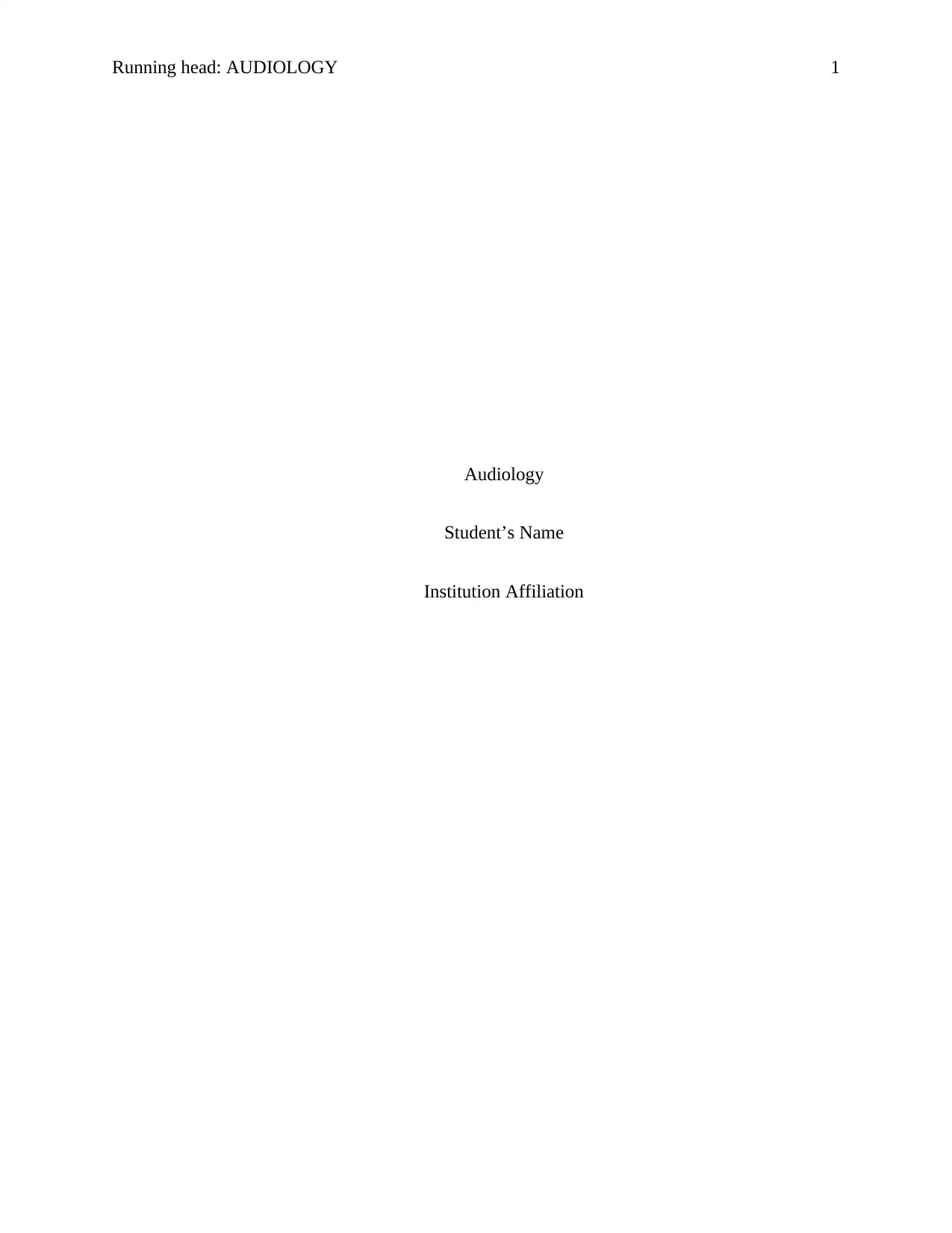
Running head: AUDIOLOGY 1
Audiology
Student’s Name
Institution Affiliation
Audiology
Student’s Name
Institution Affiliation
Paraphrase This Document
Need a fresh take? Get an instant paraphrase of this document with our AI Paraphraser

AUDIOLOGY 2
Audiology
Hearing impairments in children are known to have drastic effects on the child's ability to
communicate appropriately, grasp classroom concepts as well as affect their social life. Alberta's
case is one of those typical examples that show how drastic these effects can be on patients.
Since no single intervention or treatment can provide a lasting solution to every disability case,
applying techniques that monitor a patients' progress can curb the defect to some extent. In this
paper, I will recommend several interventions and treatments for the management of Alberta's
case.
Adopting special education
According to the Center for Disease and Control (CDC) (2019), special education is any
form of education aimed at addressing the educational needs of children with disabilities such as
hearing. Besides, children with disabilities are known to have developmental problems.
Furthermore, they have difficulty communicating fluently as well as understanding others or
being understood in class (Sampson & Thompson, 2017). For instance, other students may not
understand her case as much as the teacher does. The best way to help her is taking her to the
community of like-minded children in an exceptional environment where she can learn without
any constrains.
Technology
Alberta hears to some degree, and so she is not completely deaf. She has what we call a
residual hearing because she only hears a volume slightly lower than one heard by normal
people. Although technology may not ultimately help Alberta with her interview, it can only help
Audiology
Hearing impairments in children are known to have drastic effects on the child's ability to
communicate appropriately, grasp classroom concepts as well as affect their social life. Alberta's
case is one of those typical examples that show how drastic these effects can be on patients.
Since no single intervention or treatment can provide a lasting solution to every disability case,
applying techniques that monitor a patients' progress can curb the defect to some extent. In this
paper, I will recommend several interventions and treatments for the management of Alberta's
case.
Adopting special education
According to the Center for Disease and Control (CDC) (2019), special education is any
form of education aimed at addressing the educational needs of children with disabilities such as
hearing. Besides, children with disabilities are known to have developmental problems.
Furthermore, they have difficulty communicating fluently as well as understanding others or
being understood in class (Sampson & Thompson, 2017). For instance, other students may not
understand her case as much as the teacher does. The best way to help her is taking her to the
community of like-minded children in an exceptional environment where she can learn without
any constrains.
Technology
Alberta hears to some degree, and so she is not completely deaf. She has what we call a
residual hearing because she only hears a volume slightly lower than one heard by normal
people. Although technology may not ultimately help Alberta with her interview, it can only help
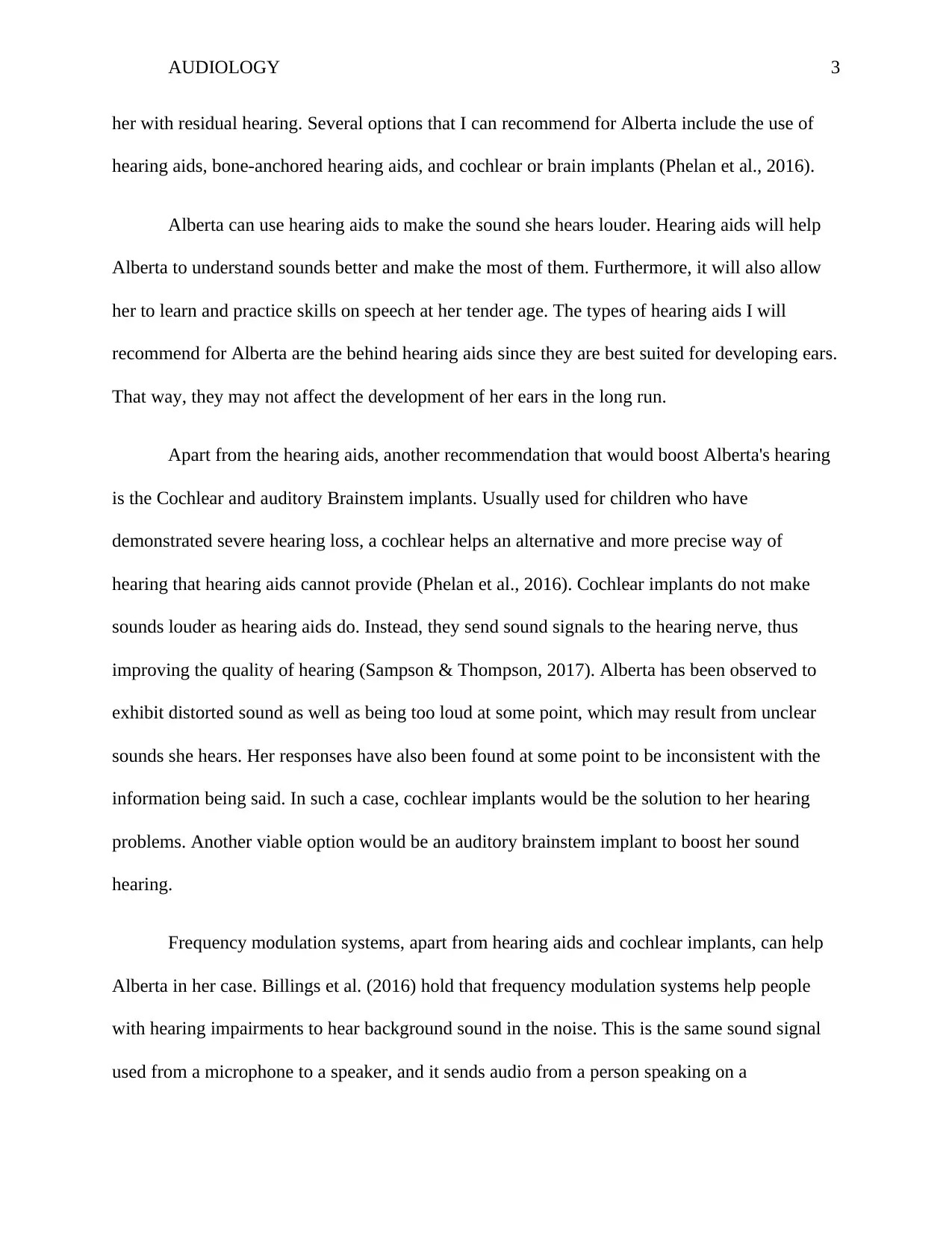
AUDIOLOGY 3
her with residual hearing. Several options that I can recommend for Alberta include the use of
hearing aids, bone-anchored hearing aids, and cochlear or brain implants (Phelan et al., 2016).
Alberta can use hearing aids to make the sound she hears louder. Hearing aids will help
Alberta to understand sounds better and make the most of them. Furthermore, it will also allow
her to learn and practice skills on speech at her tender age. The types of hearing aids I will
recommend for Alberta are the behind hearing aids since they are best suited for developing ears.
That way, they may not affect the development of her ears in the long run.
Apart from the hearing aids, another recommendation that would boost Alberta's hearing
is the Cochlear and auditory Brainstem implants. Usually used for children who have
demonstrated severe hearing loss, a cochlear helps an alternative and more precise way of
hearing that hearing aids cannot provide (Phelan et al., 2016). Cochlear implants do not make
sounds louder as hearing aids do. Instead, they send sound signals to the hearing nerve, thus
improving the quality of hearing (Sampson & Thompson, 2017). Alberta has been observed to
exhibit distorted sound as well as being too loud at some point, which may result from unclear
sounds she hears. Her responses have also been found at some point to be inconsistent with the
information being said. In such a case, cochlear implants would be the solution to her hearing
problems. Another viable option would be an auditory brainstem implant to boost her sound
hearing.
Frequency modulation systems, apart from hearing aids and cochlear implants, can help
Alberta in her case. Billings et al. (2016) hold that frequency modulation systems help people
with hearing impairments to hear background sound in the noise. This is the same sound signal
used from a microphone to a speaker, and it sends audio from a person speaking on a
her with residual hearing. Several options that I can recommend for Alberta include the use of
hearing aids, bone-anchored hearing aids, and cochlear or brain implants (Phelan et al., 2016).
Alberta can use hearing aids to make the sound she hears louder. Hearing aids will help
Alberta to understand sounds better and make the most of them. Furthermore, it will also allow
her to learn and practice skills on speech at her tender age. The types of hearing aids I will
recommend for Alberta are the behind hearing aids since they are best suited for developing ears.
That way, they may not affect the development of her ears in the long run.
Apart from the hearing aids, another recommendation that would boost Alberta's hearing
is the Cochlear and auditory Brainstem implants. Usually used for children who have
demonstrated severe hearing loss, a cochlear helps an alternative and more precise way of
hearing that hearing aids cannot provide (Phelan et al., 2016). Cochlear implants do not make
sounds louder as hearing aids do. Instead, they send sound signals to the hearing nerve, thus
improving the quality of hearing (Sampson & Thompson, 2017). Alberta has been observed to
exhibit distorted sound as well as being too loud at some point, which may result from unclear
sounds she hears. Her responses have also been found at some point to be inconsistent with the
information being said. In such a case, cochlear implants would be the solution to her hearing
problems. Another viable option would be an auditory brainstem implant to boost her sound
hearing.
Frequency modulation systems, apart from hearing aids and cochlear implants, can help
Alberta in her case. Billings et al. (2016) hold that frequency modulation systems help people
with hearing impairments to hear background sound in the noise. This is the same sound signal
used from a microphone to a speaker, and it sends audio from a person speaking on a
⊘ This is a preview!⊘
Do you want full access?
Subscribe today to unlock all pages.

Trusted by 1+ million students worldwide
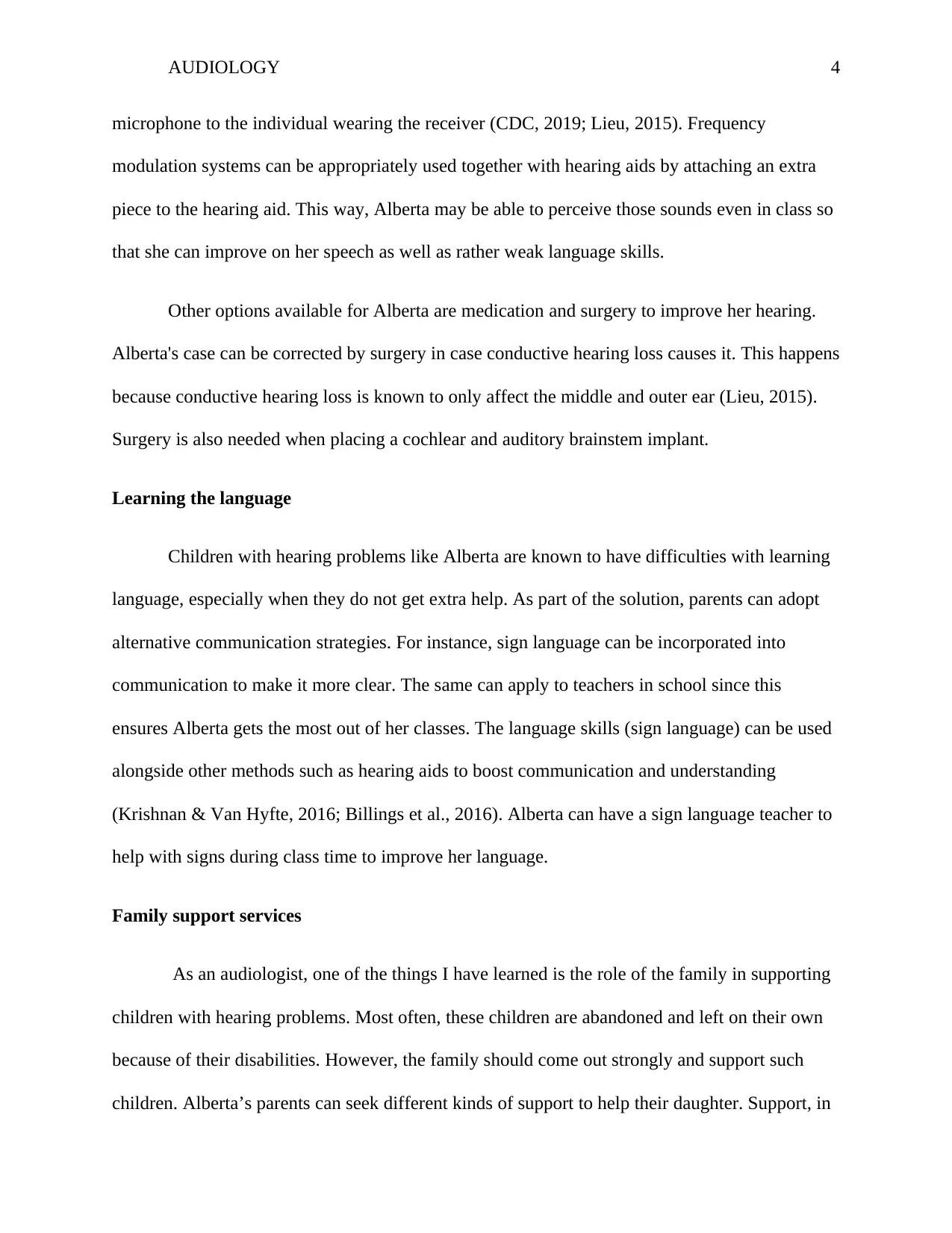
AUDIOLOGY 4
microphone to the individual wearing the receiver (CDC, 2019; Lieu, 2015). Frequency
modulation systems can be appropriately used together with hearing aids by attaching an extra
piece to the hearing aid. This way, Alberta may be able to perceive those sounds even in class so
that she can improve on her speech as well as rather weak language skills.
Other options available for Alberta are medication and surgery to improve her hearing.
Alberta's case can be corrected by surgery in case conductive hearing loss causes it. This happens
because conductive hearing loss is known to only affect the middle and outer ear (Lieu, 2015).
Surgery is also needed when placing a cochlear and auditory brainstem implant.
Learning the language
Children with hearing problems like Alberta are known to have difficulties with learning
language, especially when they do not get extra help. As part of the solution, parents can adopt
alternative communication strategies. For instance, sign language can be incorporated into
communication to make it more clear. The same can apply to teachers in school since this
ensures Alberta gets the most out of her classes. The language skills (sign language) can be used
alongside other methods such as hearing aids to boost communication and understanding
(Krishnan & Van Hyfte, 2016; Billings et al., 2016). Alberta can have a sign language teacher to
help with signs during class time to improve her language.
Family support services
As an audiologist, one of the things I have learned is the role of the family in supporting
children with hearing problems. Most often, these children are abandoned and left on their own
because of their disabilities. However, the family should come out strongly and support such
children. Alberta’s parents can seek different kinds of support to help their daughter. Support, in
microphone to the individual wearing the receiver (CDC, 2019; Lieu, 2015). Frequency
modulation systems can be appropriately used together with hearing aids by attaching an extra
piece to the hearing aid. This way, Alberta may be able to perceive those sounds even in class so
that she can improve on her speech as well as rather weak language skills.
Other options available for Alberta are medication and surgery to improve her hearing.
Alberta's case can be corrected by surgery in case conductive hearing loss causes it. This happens
because conductive hearing loss is known to only affect the middle and outer ear (Lieu, 2015).
Surgery is also needed when placing a cochlear and auditory brainstem implant.
Learning the language
Children with hearing problems like Alberta are known to have difficulties with learning
language, especially when they do not get extra help. As part of the solution, parents can adopt
alternative communication strategies. For instance, sign language can be incorporated into
communication to make it more clear. The same can apply to teachers in school since this
ensures Alberta gets the most out of her classes. The language skills (sign language) can be used
alongside other methods such as hearing aids to boost communication and understanding
(Krishnan & Van Hyfte, 2016; Billings et al., 2016). Alberta can have a sign language teacher to
help with signs during class time to improve her language.
Family support services
As an audiologist, one of the things I have learned is the role of the family in supporting
children with hearing problems. Most often, these children are abandoned and left on their own
because of their disabilities. However, the family should come out strongly and support such
children. Alberta’s parents can seek different kinds of support to help their daughter. Support, in
Paraphrase This Document
Need a fresh take? Get an instant paraphrase of this document with our AI Paraphraser
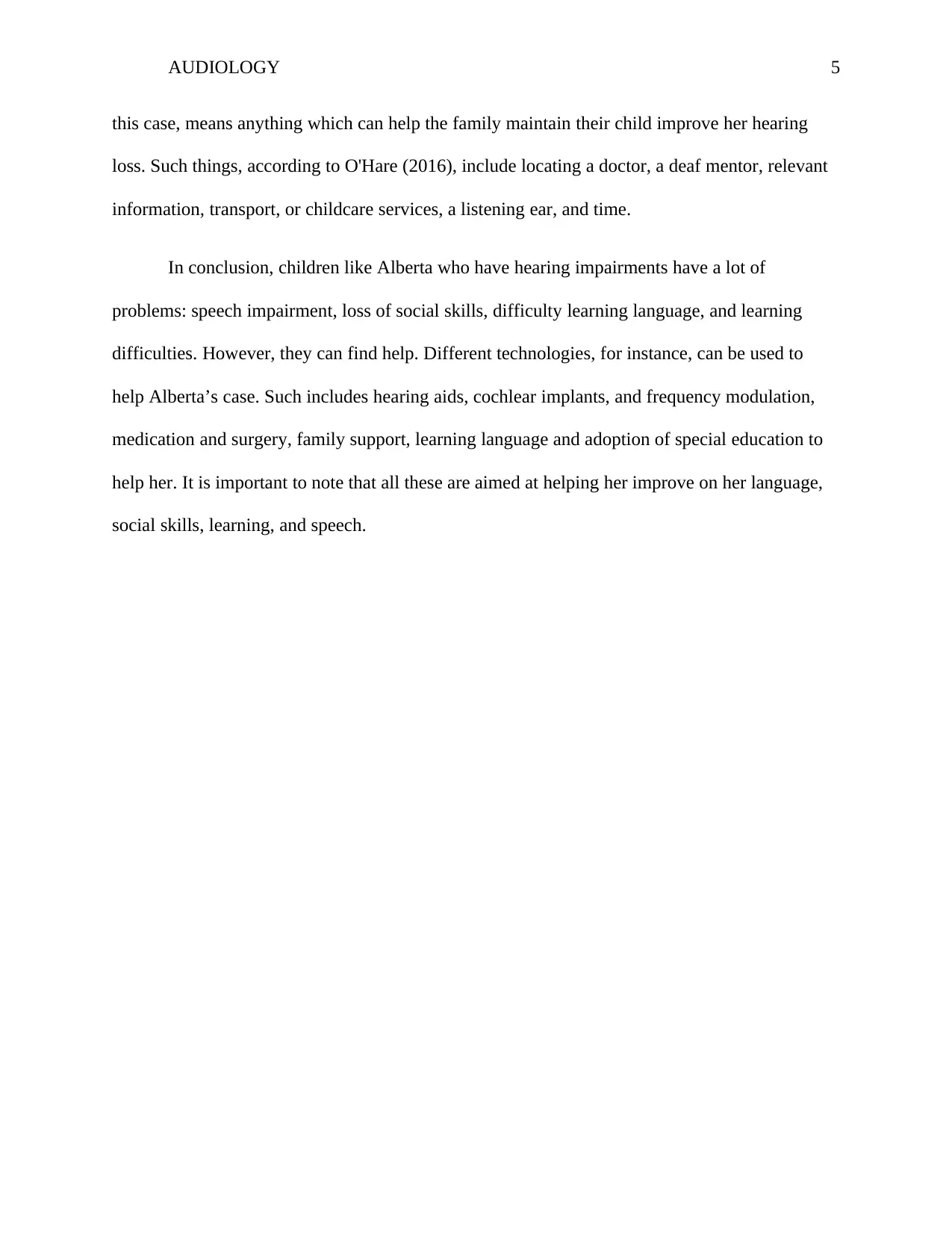
AUDIOLOGY 5
this case, means anything which can help the family maintain their child improve her hearing
loss. Such things, according to O'Hare (2016), include locating a doctor, a deaf mentor, relevant
information, transport, or childcare services, a listening ear, and time.
In conclusion, children like Alberta who have hearing impairments have a lot of
problems: speech impairment, loss of social skills, difficulty learning language, and learning
difficulties. However, they can find help. Different technologies, for instance, can be used to
help Alberta’s case. Such includes hearing aids, cochlear implants, and frequency modulation,
medication and surgery, family support, learning language and adoption of special education to
help her. It is important to note that all these are aimed at helping her improve on her language,
social skills, learning, and speech.
this case, means anything which can help the family maintain their child improve her hearing
loss. Such things, according to O'Hare (2016), include locating a doctor, a deaf mentor, relevant
information, transport, or childcare services, a listening ear, and time.
In conclusion, children like Alberta who have hearing impairments have a lot of
problems: speech impairment, loss of social skills, difficulty learning language, and learning
difficulties. However, they can find help. Different technologies, for instance, can be used to
help Alberta’s case. Such includes hearing aids, cochlear implants, and frequency modulation,
medication and surgery, family support, learning language and adoption of special education to
help her. It is important to note that all these are aimed at helping her improve on her language,
social skills, learning, and speech.
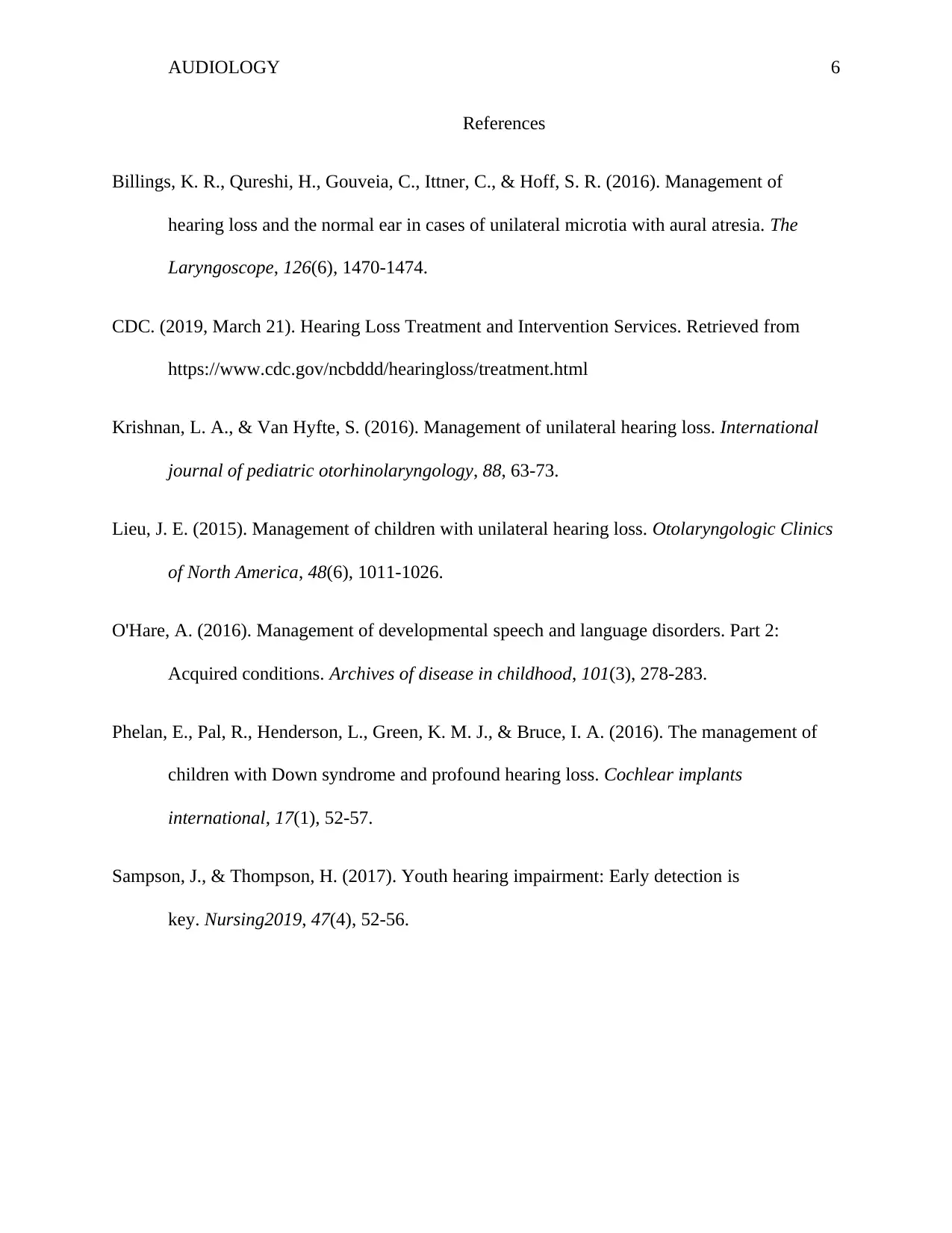
AUDIOLOGY 6
References
Billings, K. R., Qureshi, H., Gouveia, C., Ittner, C., & Hoff, S. R. (2016). Management of
hearing loss and the normal ear in cases of unilateral microtia with aural atresia. The
Laryngoscope, 126(6), 1470-1474.
CDC. (2019, March 21). Hearing Loss Treatment and Intervention Services. Retrieved from
https://www.cdc.gov/ncbddd/hearingloss/treatment.html
Krishnan, L. A., & Van Hyfte, S. (2016). Management of unilateral hearing loss. International
journal of pediatric otorhinolaryngology, 88, 63-73.
Lieu, J. E. (2015). Management of children with unilateral hearing loss. Otolaryngologic Clinics
of North America, 48(6), 1011-1026.
O'Hare, A. (2016). Management of developmental speech and language disorders. Part 2:
Acquired conditions. Archives of disease in childhood, 101(3), 278-283.
Phelan, E., Pal, R., Henderson, L., Green, K. M. J., & Bruce, I. A. (2016). The management of
children with Down syndrome and profound hearing loss. Cochlear implants
international, 17(1), 52-57.
Sampson, J., & Thompson, H. (2017). Youth hearing impairment: Early detection is
key. Nursing2019, 47(4), 52-56.
References
Billings, K. R., Qureshi, H., Gouveia, C., Ittner, C., & Hoff, S. R. (2016). Management of
hearing loss and the normal ear in cases of unilateral microtia with aural atresia. The
Laryngoscope, 126(6), 1470-1474.
CDC. (2019, March 21). Hearing Loss Treatment and Intervention Services. Retrieved from
https://www.cdc.gov/ncbddd/hearingloss/treatment.html
Krishnan, L. A., & Van Hyfte, S. (2016). Management of unilateral hearing loss. International
journal of pediatric otorhinolaryngology, 88, 63-73.
Lieu, J. E. (2015). Management of children with unilateral hearing loss. Otolaryngologic Clinics
of North America, 48(6), 1011-1026.
O'Hare, A. (2016). Management of developmental speech and language disorders. Part 2:
Acquired conditions. Archives of disease in childhood, 101(3), 278-283.
Phelan, E., Pal, R., Henderson, L., Green, K. M. J., & Bruce, I. A. (2016). The management of
children with Down syndrome and profound hearing loss. Cochlear implants
international, 17(1), 52-57.
Sampson, J., & Thompson, H. (2017). Youth hearing impairment: Early detection is
key. Nursing2019, 47(4), 52-56.
⊘ This is a preview!⊘
Do you want full access?
Subscribe today to unlock all pages.

Trusted by 1+ million students worldwide
1 out of 6
Your All-in-One AI-Powered Toolkit for Academic Success.
+13062052269
info@desklib.com
Available 24*7 on WhatsApp / Email
![[object Object]](/_next/static/media/star-bottom.7253800d.svg)
Unlock your academic potential
Copyright © 2020–2025 A2Z Services. All Rights Reserved. Developed and managed by ZUCOL.